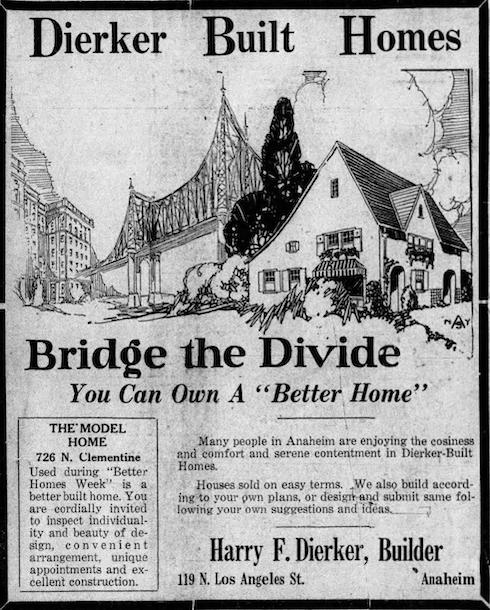Better Homes of America in Anaheim
BY VALERIE SMITH
Model houses from the 1920s are "hiding in plain sight" in cities all over the U.S. Studying these houses has revealed the important local and national history of the Small House Movement and a program called Better Homes in America. Santa Barbara, Sacramento, and Stockton, California, are a few cities that received national attention for the small house designs they demonstrated during the program. Orange County's participation was less widespread, but Fullerton and Anaheim were active participants, and in this article, Valerie Smith shares her findings about Anaheim's program.
The 1920s Small House Movement
The Small House Movement began in 1919 when architects in Minneapolis, Minnesota, formed the Architects' Small House Service Bureau.(1) The goal was to elevate the design of small houses for moderate incomes. The Bureau was endorsed by the American Institute of Architects (AIA), and small house designs were published in plan books and newspapers for prospective homebuilders. The market quickly became saturated with small house designs commercialized by builders, trade associations, and realtors. Yet, the Bureau kept its original goal to approach small house design as a civic duty, not a money-making venture.
A small house built from a plan published by the Architects’ Small House Service Bureau in the 1920s. Courtesy of Valerie Smith.
Small houses of the 1920s are not what is referred to today as "tiny houses." The term "small house" in the 1920s referred to a compact design that eliminated "wasted" space such as hallways, large porches, and rooms such as the parlor and formal dining room in some plans. Small houses were defined by the Architects' Small House Service Bureau as having three to six principal rooms that could be built for under $10,000 but, on average, for $5,000.(2)
A compact four-room house plan by the Architects’ Small House Service Bureau, 1921. Courtesy of Valerie Smith.
The Architects' Small House Service Bureau promoted houses of individualization--achieved by the prospective home builder selecting a stock plan for a house to be built on a vacant lot. Comfort, convenience, natural light, ventilation, modern equipment, and efficiently arranged rooms were key characteristics. Developing automobile suburbs outside city centers allowed for larger lots which meant a house could be turned sideways on the lot. This allowed for various period-style designs since houses no longer had to be tall and narrow as railroad and streetcar suburb lots dictated.
The ideal small house design lot arrangement was 50 x 100 foot lot, and a detached garage at the rear. The rear yard was to have areas for growing vegetables, drying clothes, and for recreation. Landscaping was included in small house plans as well.
Better Homes in America
A government-endorsed program Better Homes in America was founded in 1922 to elevate small house design, implement social reform, and address the post-World War I demand for single-family houses. Better Homes in America published pamphlets for prospective homeowners, including a plan book of small house designs. The Architects' Small House Service Bureau designed the house plans and newspapers including the Santa Ana Register advertised the plan book.(3) Model houses were demonstrated in cities throughout the United States during the annual Better Homes Week to show prospective homebuilders what could be achieved in a small house.
Better Homes in America architect-designed stock plan book with plans drawn by the Architects’ Small House Service Bureau.
In 1924, Anaheim participated in Better Homes Week, opening a model house from May 11-17. Located at 726 North Clementine Street, it was built in an eclectic French or English style with a touch of Storybook cottage.
Harry F. Dierker was the builder of the Anaheim model house, and he purchased the undeveloped lot in 1923.(4) It is unknown if he used a small house stock plan for inspiration or drew the plans himself. Dierker advertised the model house as having "individuality and beauty of design, convenient arrangement, unique appointments, and excellent construction."(5)
By the time the model house was displayed for Better Homes Week, Dierker had already built twenty-three homes in north Orange County, with fifteen in Anaheim. Nine of them are located on North Clementine. Like many builders in the 1920s, Dierker’s newspaper advertisements claimed that "Dierker-Built" homes were "Better Homes."
The Better Homes Week model house, 726 North Clementine Street, Anaheim, CA, as it looks today.
Advertisement for the model house at 726 North Clementine in Anaheim and “Dierker-Built Better Homes.”
The interior was decorated in a Spanish style which the Anaheim Builder described as "modern, of course, to the latest degree but still typically Spanish."(6) The newspaper also noted how local Anaheim merchants furnished the home to give visitors an idea of the best interior design for a small house. The house was furnished by Anaheim's S.Q.R. and Stroup-Barnes furniture stores, along with Falkenstein's department store and J.C. Penney.
The S.Q.R. store in Anaheim provided furniture for the model house.
Model houses were outfitted with all the modern equipment. Vendors were eager to donate their products so they could advertise their involvement in the model house during Better Homes Week.
Women coordinated Better Homes Week campaigns around the country, and Anaheim’s campaign was led by Mrs. M.E. Canby. The campaigns always involved local communities in the constructing, furnishing, hosting, and promoting of the model houses. The Kiwanis, Rotarians, Ebell, and Business and Professional Women's clubs in Anaheim helped with the model house in 1924. Anaheim's Better Homes Week was a success, with nearly 2,000 people visiting 726 North Clementine Street.(7) The Orange County Plain Dealer applauded the campaign saying Anaheim was "the only city in the county which answered the call of our government for a "Better Homes Week."(8)
Preserving Small House Movement Assets
Today, 726 North Clementine Street is part of the Colony Historic District and is listed on the city of Anaheim’s Qualified Historic Structures List for its contribution as a 1920s period-style house.(9) Discovering its history as a model house also provides an extra layer to its significance as an individual historic asset (both locally and nationally). As a reference point, newly-discovered Better Homes model houses in Santa Barbara have led to momentum and recognition of small house movement assets by the city’s Landmarks Commission. There are abundant opportunities to preserve and document small houses in California if more of this forgotten history is uncovered. The role of architect-designed stock plans and model houses from the 1920s should be documented and assets preserved from this important time in single-family house design.
A historic and current image of 734 North Clementine Street, Anaheim, was also built by Harry Dierker.
Author and historian, Valerie Smith.
Valerie Smith is a 2022 graduate of Columbia University’s Master’s program in Historic Preservation. She earned a B.A. in Studio Art with an emphasis in photography from Hope College. She is currently working as an architectural historian in Los Angeles and continuing her thesis research on the Small House Movement with a focus on California cities in the 1920s.
ENDNOTES
1) National Park Service U.S. Department of the Interior, Historic Residential Suburbs, 2002, 56, https://shpo.nv.gov/uploads/documents/NR_Bulletin_Suburbs-compressed.pdf.
2) “Principal rooms” refers to kitchen, bedrooms, and dining rooms not bathrooms or screened-in porches.
3) “Society Urges Better Homes in America,” Santa Ana Register, August 15, 1924, 11.
4) “Primary Record for 726 North Clementine Street,” State of California Department of Parks and Recreation, 2007. 726 North Clementine contained a restrictive covenant set in place by former owners James Owens and Mary Jones preventing future sales to non-white owners. While Better Homes in America promoted well-designed houses for people with moderate incomes, systemic racism was rampant in 1920s automobile suburbs. Better Homes in America featured houses for immigrants and the Black community but did not address systemic racism found in neighborhoods such as the Owens-Jones Tract.
5) “Dierker-Built Better Homes,” The Orange County Plain Dealer, Advertisement, May 12, 1924, 5.
6) “Better Homes Model Holds Inspiration,” Anaheim Bulletin, May 14, 1924, 1.
7) “C. of C. Gets Report on Better Homes,” The Orange County Plain Dealer, June 6, 1924, 10.
8) “Relationship of Civic Clubs to the Chamber of Commerce, The Orange County Plain Dealer, June 13, 1924, 8.
9) City of Anaheim List of Historic Structures,” City of Anaheim Planning Department, 2016, Last Accessed October 31, 2022, https://www.anaheim.net/DocumentCenter/View/1486/Contributors-and-Citywide-Historic-Structures?bidId=.
SOURCES
“Better Homes Model Holds Inspiration,” Anaheim Bulletin, May 14, 1924, 1.
“C. of C. Gets Report on Better Homes,” The Orange County Plain Dealer, June 6, 1924, 10.
“Dierker-Built Better Homes,” The Orange County Plain Dealer, Advertisement, May 12, 1924, 5.
National Park Service U.S. Department of the Interior, Historic Residential Suburbs, 2002, 56, https://shpo.nv.gov/uploads/documents/NR_Bulletin_Suburbs-compressed.pdf.
“Primary Record for 726 North Clementine Street,” State of California Department of Parks and Recreation, 2007.
“Relationship of Civic Clubs to the Chamber of Commerce, The Orange County Plain Dealer, June 13, 1924, 8.
“Society Urges Better Homes in America,” Santa Ana Register, August 15, 1924, 11.










